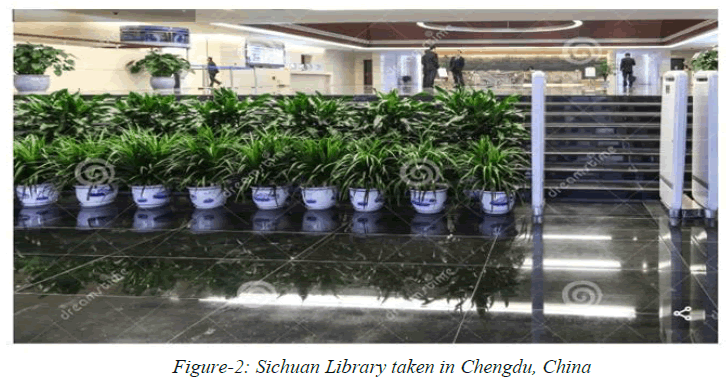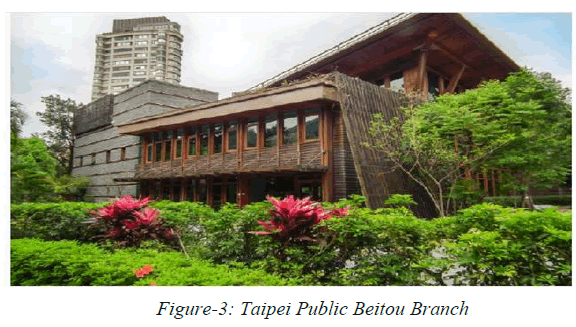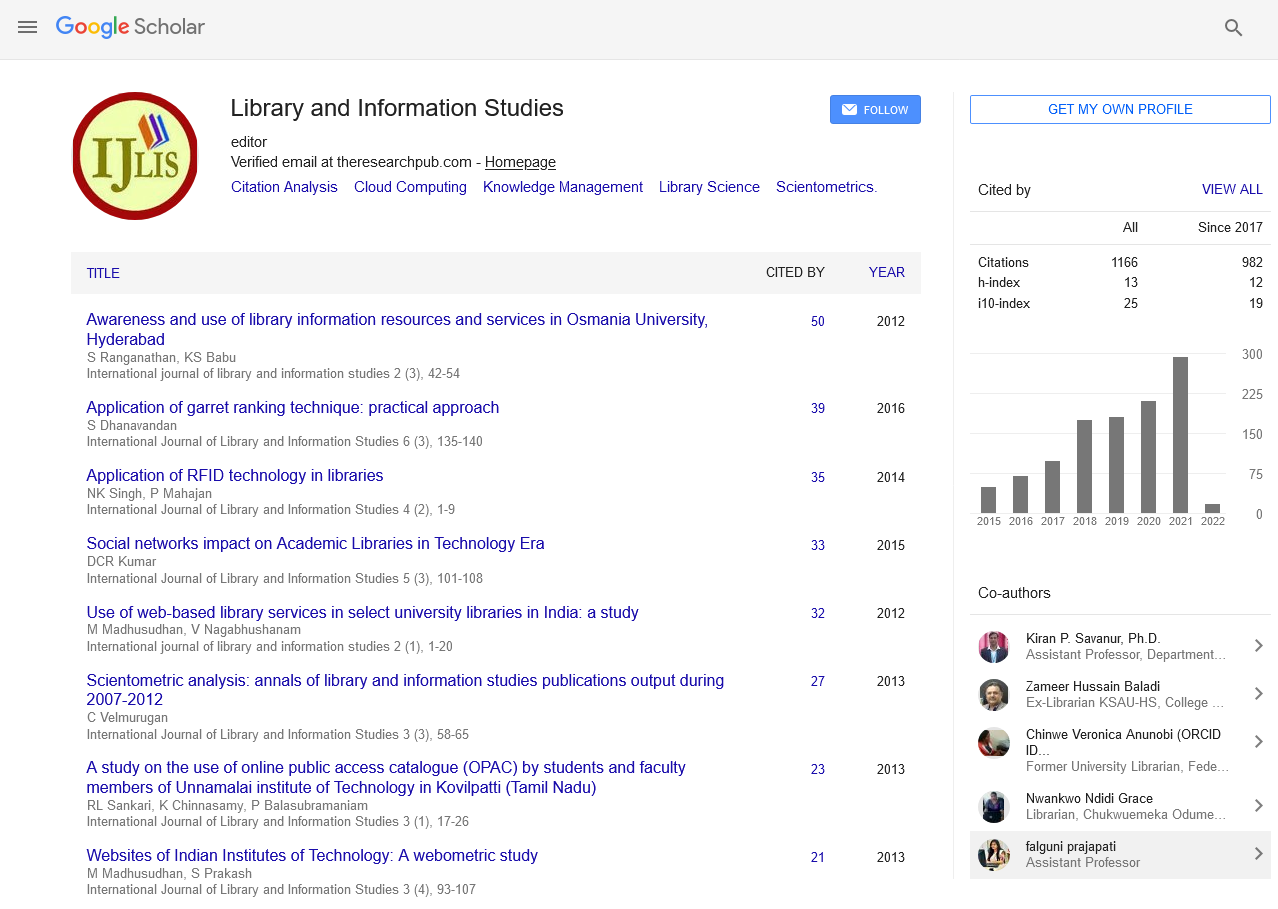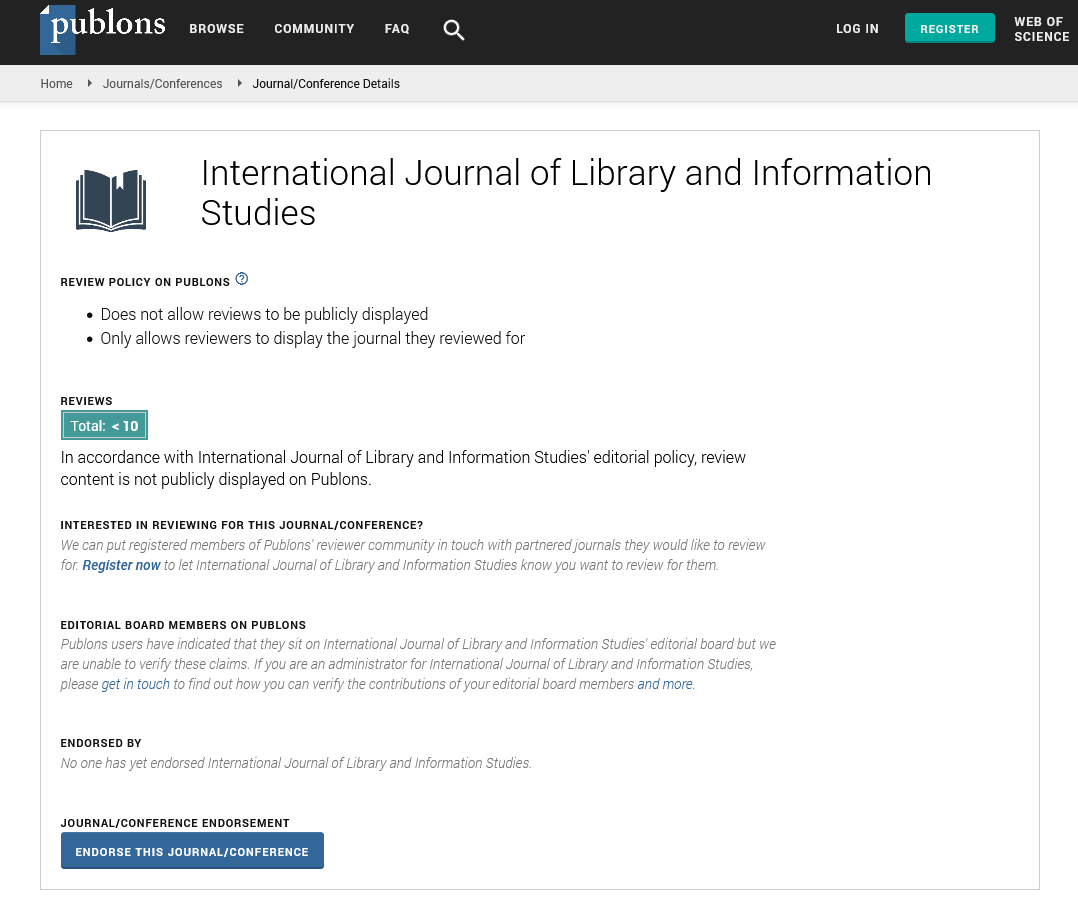Review - (2022) Volume 12, Issue 1
Green Library: A New Vision of the 21st Century
Muhammad Anwar1* and Tang Zhi Wei2*Abstract
The present study aims are to find out the importance of a green library. This study is attempted to disclose the environmental effects on the library that need to be green. The present incorporated to see the issues, benefits, and motives behind the going green. The survey method was used to collect data from different databases. The qualitative research design was used to complete this paper. The collected literature has been reviewed according to the selected objectives. The reviewed literature has shown that the green library movement has taken place all around the globe. The findings of the study have revealed that very nation is working hard to green their libraries. The literature disclosed that its need for time to green the library for major and minor destruction of global warming. It would be suggested that every nation should follow the green library standards to maintain and sustain their library to make friendly.
Keywords
Green Library, Vision, Century, Sustainable.
Introduction
Libraries are always considered as a treasure of knowledge and non-profit organization. The libraries are also known as the mainstream of information and knowledge. Today, the world has been changed drastically by information technologies and their associated tools. Besides these facts, the libraries are closely associated with the natural environment. The libraries are always in transition mode and they are accepting the new change for themselves as well as for their society. The libraries are always ready to accept the changes like traditional to hybrid and then hybrid to virtual then virtual to now green. Nikam (2017) agreed upon the newer concept of the green library not just do the library green also maximize the thoughts of library potential users. Additionally, the green library is not to green the library only its services and sources, but also its associated environment and area of the library. Meher & Patabhoi (2017) identified the green library movement was started at the beginning of the 1990s. The movement of the green library is growing day by day worldwide and every country is striving hard to green their libraries to prevent the library resources. Meanwhile, the Library professionals are accepting this great change and they are taking great interest to green their library. Moreover, the green library is also known as a sustainable library. Mcelrath & Sufferland (2015) the green library movement is expanding day by day and before this movement, no one is well aware of global warming and its impact in the future on libraries and information centers. Furthermore, the Library professional is not aware of the impact of global warming and climate changes upon the libraries. The present age green libraries need to resolve global warming and climate changes issues and makes library friendly with environment green. There should be a proper policy to adopt the green library to minimize global warming and climate changes.
Definition of green library
According to Wikipedia(2020) “A green library is designed to minimize negative impact on the natural environment and maximize indoor environmental quality by means of careful site selection, use of natural construction materials and biodegradable products, conservation of resources (water, energy, paper), and responsible waste disposal (recycling, etc.)” (Figure 1).

Figure-1: The National Library of China
Research Questions
1. What is the impact of climate change on libraries?
2. What are the issues and challenges of a green library?
3. What are the benefits of green Libraries?
4. What is the role of stakeholders for greening libraries?
Research Methodology
The present study was based on a literature review. The qualitative research method was used to complete this paper. The survey method was used to collect the related literature from the different sites, e.g. Google, Google Scholar, Wikipedia, and other databases to gather the data and review according to the objectives of the study.
Review of Related Literature
Ahmed & Jidokson (2018) find the implementation of the green library towards the environment world. They identified what kinds of factors can be more effective in the implementation of the green library. Disclosed the service effect in the implementation of the proposed framework to do the library green.
Meher & Parabhoi (2017) searched the green library: an overview, issues with special reference to Indian libraries. They investigated what kind of environment can be dangerous to the green library. They also find society; an organization can be helpful for establishing better green libraries in India. The authors identified the role of the United Nation development program in greening the libraries using LEED (Leadership in Energy and Environment Design).
Pangail (2015) investigated the meaning standard and practice of green libraries. She mentioned that every part of the world including India establishing their libraries green. She stressed that environmental challenges and climate changes can be effects greening libraries.
Datta (2015) investigated that green is the new black: bringing the libraries into the green scene. She mentioned that environmental changes can be a sign of damage to libraries and library professionals can make things easy for themselves to protect their libraries to do the green. She Provides a quote “Live green, Love green and Thinks Green” (Figure 2).

Figure-2: Sichuan Library taken in Chengdu, China
Issues and challenges associated with green libraries
The present modern age of information explosion has been expanded at a drastic level. The environmental factors and other factors are damaging the Arizona of library environment rapidly. Nikam (2017) stressed the sustainability of green libraries that could help librarians to make the environment clean and good for library users. Likewise, the librarians are looking confident to make their libraries sustainable and effective. The advancement and progression of ICTs and its associated tools are influencing the lifestyle of an individual library as well as a collective one. Thomas (2017) mentioned that the dewier and sunlight and ultraviolet rays could be the cause of damaging the books and other resources of the library (Figure 3).

Figure-3: Taipei Public Beitou Branch
Benefits of green libraries
Greening the libraries mean to protect the library from the climate changes and environmental effects that could destroy the library easily. So, there is several studies have been indicated the benefit of greening the libraries. Thomas (2017) identified some of the points of greening the libraries which as follows e.g. less gas radiation, green roofs, electricity consumption.
The motive to do the libraries green
Every library is its features and standard to build and make its atmosphere clean, healthy and the number of motives behind the scene of Green Libraries. Thomas (2017) mentioned some of the reasons e.g. low costs of constructions, less budget, availability of energy resources and reduction of carbon footprint.
Green design elements for libraries
Brown (2003) identifies the following green design elements, which can be incorporated into libraries:
•Community collaboration-makes sure those community assets are efficiently used and help to maintain public support;
•Daylight-pair daylight with artificial lighting to reduce energy costs;
•Green materials-use renewable materials like wood, linoleum, bamboo, and cork;
•Green roofs;
•Raised floor systems;
•Energy efficiency;
•Natural ventilation;
•Green power and renewable energy;
•Indoor environmental quality.
Sornasundari & Sara (2016) stated major green library’s initiatives throughout globe which are depicted in Table 1.
| Name of the Library | Place | Country | Features |
|---|---|---|---|
| Anything Brighton | Brighton | USA | First carbon-positive library |
| Crowfoot branch, Calgary Public Library | Calgary | Canada | Incorporates energy and daylight harvesting, reduce the use of water and recycled materials. |
| Anna-Centenary Library | Chennai | India | Library block at angle that allows maximum daylight and eco-friendly |
| Karnataka University Library | Dharward | India | No books shelves, chairs or tables but benches are installed under the trees so that students can sit and read the books taken from the university library. |
| The National Library | Singapore | Singapore | First green library for kids. |
Table 1: Major Green library’s Initiatives throughout Globe
Conclusion
Sustainable, going green and friendly environment are the synonyms of each other. The present era is very much curial for libraries to maintain, sustain themselves for unprecedented destruction in the future. Global warming and greenhouse effects are putting a negative impact on libraries that’s why it’s time to green the library to prevent them from an unexpected explosion of seasonal events. Bhattacharya (2017) addresses that the libraries should plan for green library because it is cheap and maximize the global warming that can affect the library resources. Additionally, such equipment and tools should be used that can protect the library resources and save the energy level. Pangail (2015) mentioned that going green has been a hot issue in the present era. Moreover, going green the library movement was initiated in different countries e.g. India, USA, UK, etc. the going green the library is to stable the library for the long term and make sure that every aspect of the library will be green as required by the time of global warming. The number of standards has been formulated to make library green so these standards should be used to green the library and protect them unexpectedly destruction in the coming years.
References
- Nikam, S. "Green library: an emerging concept." Knowledge Librarian 4.6 (2017): 190-198.
- Meher, Puspanjali, and Lambodara Parabhoi. "Green Library: An overview, issues with special reference to Indian libraries." International Journal of Digital Library Services 7.2 (2017): 62-69.
- McElrath, Eileen, and S. Sutherland. "Environmental Sustainability and Libraries." International Journal of Humanities and Social Science 5.12 (2015): 13-23.
- Wikipedia. “Cecil H. Green Library.” Academic Libraray, Standford University, California, USA.
- Ahmed, Serge H. and Jidokson, V. A. J. “The Implementation of Green Library towards Environment World.” Research Hub 4.4 (2018):36-43.
- Pangail, Ramyia Krishnan. "Green libraries: meaning, standards and practices." Episteme 4.3 (2015): 1-9.
- Datta, Swati. "Green is the new black: Bringing the libraries into the green scene." International Journal of Digital Library Services 5.3 (2015): 59-68.
- Thomas, Raysh. "Green libraries: India vs International scenario." Scholarly Research Journal for Interdisciplinary Studies 4.37 (2017): 8645-8654.
- Brown, Bill. "The new green standard." Library Journal 128.20 (2003): 61-64.
- Bhattacharya, Anindya. "Green Library and its utilities in modern day library service: A study." International Journal of Next Generation Library and Technologies 3.3 (2017): 1-11.
- Sornasundari, R. and C. Sara. "Green Library: a study." International Journal of Research Instinct 3.2 (2016): 616-621.
Author Info
Muhammad Anwar1* and Tang Zhi Wei2*2Department of Political Science and Public Administration, University of Electronic Science and Technology-610056, Chengdu, China
Received: 24-Mar-2022, Manuscript No. IJLIS-22-58409; Editor assigned: 29-Mar-2022, Pre QC No. IJLIS-22-58409(PQ); Reviewed: 12-Apr-2022, QC No. IJLIS-22-58409; Revised: 19-Apr-2022, Manuscript No. IJLIS-22-58409(R); Published: 29-Apr-2022, DOI: 10.35248/2231-4911.22.12.827
Copyright: This is an open access article distributed under the terms of the Creative Commons Attribution License, which permits unrestricted use, distribution, and reproduction in any medium, provided the original work is properly cited.
Call for Papers
Authors can contribute papers on
What is Your ORCID
Register for the persistent digital identifier that distinguishes you from every other researcher.
Social Bookmarking
Know Your Citation Style
American Psychological Association (APA)
Modern Language Association (MLA)
American Anthropological Association (AAA)
Society for American Archaeology
American Antiquity Citation Style
American Medical Association (AMA)
American Political Science Association(APSA)





